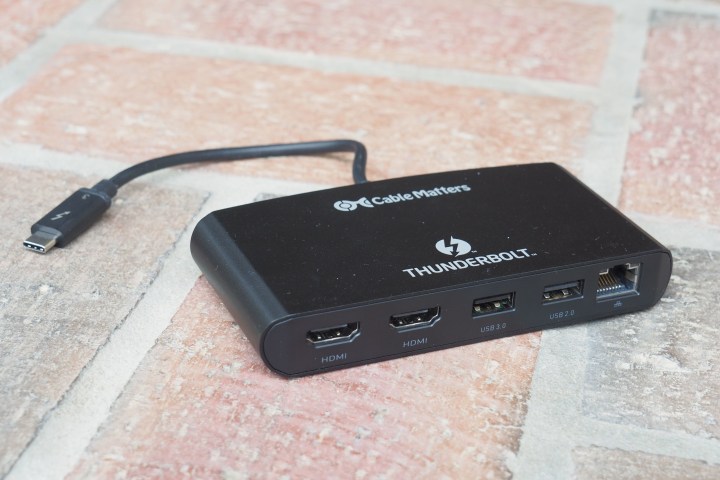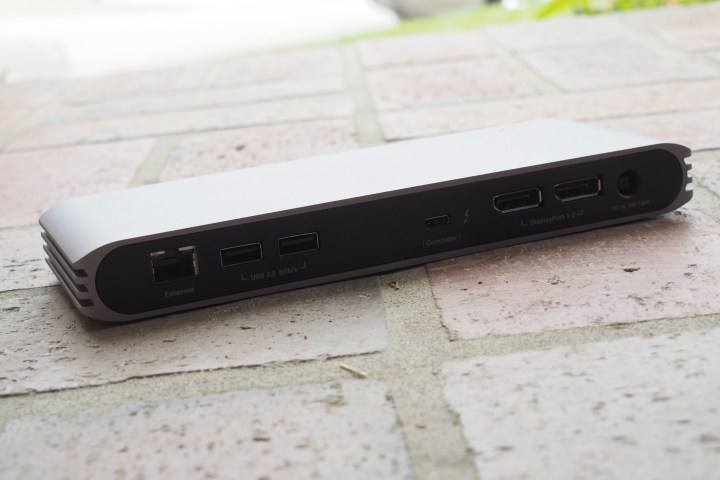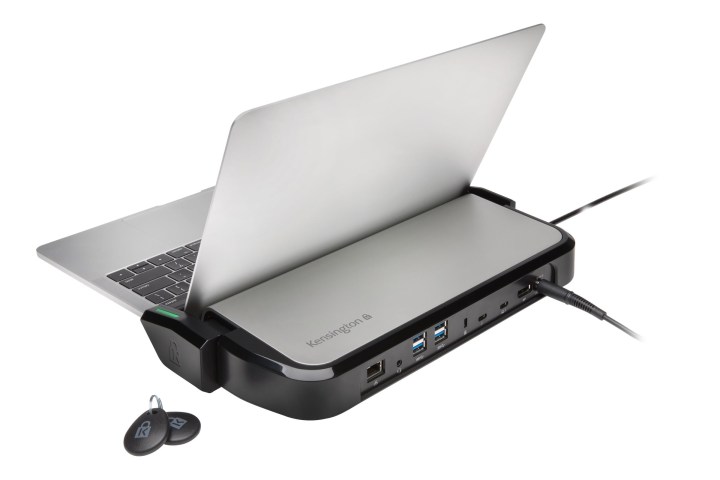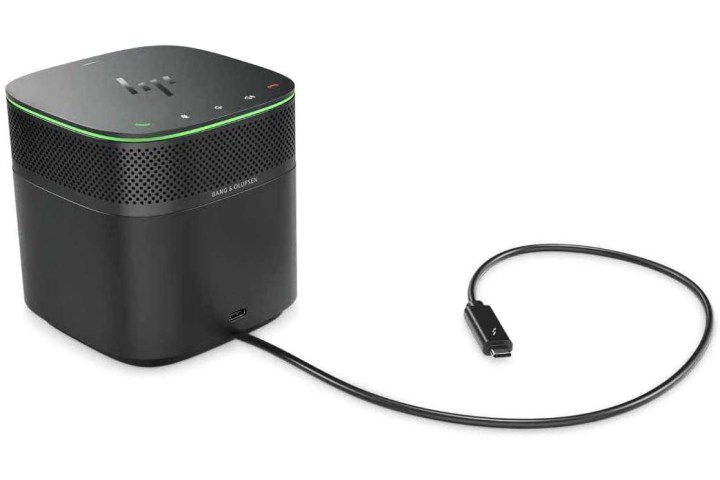It doesn’t matter if you’re using a new MacBook Pro with Apple’s M1 chip or a Mac Mini from a few years back — you’ll need a Thunderbolt 3 dock to give your computer the connectivity it deserves. A good Thunderbolt 3 dock will give you a few more ports. The best Thunderbolt 3 docks give you more, allowing you to turn your laptop into a desktop with a single connection.
- The best Thunderbolt 3 docks at a glance
- The best Thunderbolt 3 dock: CalDigit TS3 Plus Dock
- The best budget Thunderbolt 3 dock: Cable Matters Dual HDMI Thunderbolt 3 Dock
- The best Thunderbolt 3 dock for MacBooks: CalDigit USB-C Pro Dock
- The best Thunderbolt 3 docking station: Kensington LD5400T
- The best Thunderbolt 3 dock for working from home: HP G2 Thunderbolt 3 with Audio
- Research and buying FAQ
We tried out 10 different Thunderbolt 3 docks on multiple laptops to test consistency, power, usability, and price. Thunderbolt 3 might be a firm standard, but that doesn’t mean these peripherals are all made equal. While audio, Ethernet, and USB connectivity might be stable, features like external display support were very hit or miss.
With that testing in mind, a few options easily stood out from the crowd. The best Thunderbolt 3 dock is the CalDigit TS3 Plus, not only because of its compatibility but also its dense port selection.
The best Thunderbolt 3 docks at a glance
- The best Thunderbolt 3 dock: CalDigit TS3 Plus
- The best budget Thunderbolt 3 dock: Cable Matters Dual HDMI Thunderbolt 3 Dock
- The best Thunderbolt 3 dock for MacBooks: CalDigit USB-C Pro
- The best Thunderbolt 3 docking station: Kensington LD5400T
- The best Thunderbolt 3 dock for working from home: HP G2 with Audio
The best Thunderbolt 3 dock: CalDigit TS3 Plus Dock

The CalDigit TS3 Plus dock is easily the best Thunderbolt 3 Dock you can buy. It’s reliable, consistent, and includes every port imaginable.
It should be clear by now that CalDigit produces well-behaving products. The TS3 Plus was the most reliable and consistent dock we tested, with its sibling, the USB-C Pro, falling just a step behind. Each of the laptops we tested worked better with the TS3 Plus than with any other dock, enabling convenient plug-and-play almost across the board. It was incredibly refreshing to simply plug in a laptop and watch both of the displays connect at a full 60Hz.
The TS3 Plus also provides the most comprehensive array of connections and 87 watts of power delivery. You get five USB-A ports, two USB-C ports, one additional Thunderbolt 3 port, both audio in and out connections, a digital optical connection, an SD card reader, and Gigabit Ethernet. The only downside is the single DisplayPort connection, meaning you need a dongle to connect a second display. CalDigit even managed to pack all of that connectivity into a box that’s relatively small compared to some of the competition. It’s not a real looker, but it’s a highly functional brick that doesn’t take up too much space and won’t stick out on your desk.
The TS3 Plus is expensive at $250, however. But the extra cost is well worth it for the diversity of connectivity and the impressive compatibility and reliability. If you want to be as sure as you can be in picking a dock that will work with your laptop, then the TS3 Plus is your best choice.
The best budget Thunderbolt 3 dock: Cable Matters Dual HDMI Thunderbolt 3 Dock

The least expensive dock that we tested was the Cable Matters Dual HDMI Thunderbolt 3 Dock. It’s also the most portable, making for a nice travel companion.
At around $100, the Cable Matters TB3 was the clear pick for this category. In this price bracket, you usually have to give something up, with full-featured docks running around the $200 mark. Remarkably, the TB3 gives up very little.
What the Cable Matters dock gives up most of all is power delivery — it’s fully powered by the laptop and doesn’t even come with a power brick. But that’s OK because that also makes it a highly portable dock. Just stick it in your backpack along with your laptop, and you can move from office to office with ease.
The Cable Matters Dual HDMI Thunderbolt 3 Dock only two USB-A ports, a Gigabit Ethernet port, and two HDMI ports, but that’s enough to set up a reasonably well-equipped office. And the dock did a great job of connecting to the two 4K displays at 60Hz via the two HDMI ports, with only the HP Spectre x360 15 giving it fits.
The best Thunderbolt 3 dock for MacBooks: CalDigit USB-C Pro Dock

CalDigit has two possible placements in this category. Its TB3 Plus and USB-C Pro docks both worked best with the MacBook Pro 16 out of all the docks we tested.
However, the USB-C Pro was more reliable overall, requiring fewer reboots to get everything up and running. The best part? It works with non-Thunderbolt 3 laptops as well and is a bit cheaper than the TB3 Plus.
The CalDigit USB-C Pro is easily the prettiest dock we tested, featuring a long, shallow design marked by a dark gray aluminum that matches MacBooks well. It goes far beyond just aesthetics, though.
The MacBook Pro 16 we tested here was a finicky machine when it came to connecting to both of the 4K displays. It’s the only laptop that routinely needed to be rebooted for everything to connect correctly, and that included from session to session. In other words, even once we had everything working, if we rebooted the laptop, we would sometimes need to reboot again to get both displays to connect. That was true with all of the docks, but the CalDigit USB-C Pro was by far the most reliable in this regard.
The USB-C Pro is the best dock to use with the MacBook Pro, and it provides a robust set of connectivity. You get three USB-A ports, one USB-C port, audio in and out, an SD card reader, and a Gigabit Ethernet port. The two DisplayPort inputs provide dongle-free connections to two external displays. But perhaps the most interesting aspect of the USB-C Pro is that it can also connect to laptops with non-Thunderbolt 3 USB-C ports. You’ll need to drop down to the USB-C specifications, such as two 1080p displays instead of 4K and much slower bandwidth, but it’s an excellent option for anyone who needs to support more than one laptop.
The CalDigit USB-C Pro Dock is also on the lower end of the price scale at $200. Given its exceptional reliability, 85-watt power delivery, and compatibility with USB-C, the USB-C Pro is a solid second choice behind the TS3 Plus.
The best Thunderbolt 3 docking station: Kensington LD5400T

All of our previous picks are Thunderbolt 3 “docks” in name only. The Kensington LD5400T is a literal dock, wrapping around the back of your laptop to give you a single, cohesive unit.
The LD5400T is quite large as a result, but it has the connectivity to justify its size. It comes with four USB-A 3.1 ports, a single DisplayPort connection, a Gigabit Ethernet jack, 3.5mm in and out, and two Thunderbolt 3 ports, one that delivers up to 85W of power and another for video or daisy-chaining.
It lacks an HDMI port, but you can still use a dual-monitor setup using the DisplayPort and a Thunderbolt 3 port. With a single screen, the HD5400T delivers 5K at 60Hz, while with two screens, it delivers 4K at 60Hz.
The LD5400T comes from Kensington, so unlike our previous picks, security is a big talking point here. Alongside the connectivity, there’s a Kensington Lock slot, allowing you to tether the dock if you have a cable. Even if you don’t, there are other ways to secure the LD5400T.
It comes with two mounting holes on the bottom, so you can mount it to a desk for a permanent setup, as well as a removable cable lock, allowing you to tether the dock wherever you go. The two hinges that wrap around the screen and make the Kensington LD5400T a proper dock lock, too, using the two included K-Fobs. You can assign one or both K-Fobs to your unit and lock and unlock the hinges with a tap.
The best Thunderbolt 3 dock for working from home: HP G2 Thunderbolt 3 with Audio

The HP G2 is a modular dock that stands up to the CalDigit TS3 Plus when it comes to connectivity, but not build quality. It’s not built poorly, but the G2 is constructed out of plastic, despite being more expensive than the TS3 Plus.
It’s the detachable speaker/microphone combo unit that sets the G2 apart. You can purchase the G2 without this audio module, but we’d recommend picking it up as a combo (HP charges $20 for the dock as part of the combo but charges $65 for it on its own). The module is Skype for Business certified, and it connects to the G2 without cabling — perfect if you’re working from home.
The G2 isn’t a slouch when it comes to general connectivity, though. On the back, the G2 comes with two USB-A 3.0 ports, Gigabit Ethernet, two DisplayPort connections, a single USB-C connection, a Thunderbolt 3 port, and a VGA port (if you still have a VGA monitor kicking around).
Additionally, the G2 comes with a 3.5mm jack and USB-A 3.0 port on the side, as well as a USB-C connection on the front. Situating the ports in this way is great, allowing you to tuck away the cables running to your monitor and laptop while still having access to a few USB connections for quick switching.
The only downside is the Thunderbolt 3 cable that runs to your laptop. The HP G2 is only 2 feet long, and although you can replace it, you’ll need to order a kit from HP and take apart the G2 to do so.
Research and buying FAQ
- What is Thunderbolt 3?
- Why are Thunderbolt 3 docks so expensive?
- What are Thunderbolt 3 docks good for?
- Is Thunderbolt 3 the same thing as USB-C?
- When did Thunderbolt 3 come out?
- Does my laptop have Thunderbolt 3?
What is Thunderbolt 3?
Thunderbolt 3 is a data standard created by Intel and first supported by Apple. Thunderbolt 3 is the third generation of that data standard, first released in the mid-2010s. It uses the physical USB-C port and offers data speeds up to 40Gbps, has the ability to output two 4K video streams at 60Hz, and can charge mobile devices with the right support. You can read more about it here.
What are Thunderbolt 3 docks good for?
Even the best laptops can be connectivity-challenged. While desktop PCs have scads of ports and internal expandability, laptops are stuck with what ships from the factory. If you want to increase your storage space, add an external display, connect to your network over Ethernet, or perhaps plug in an SD card, you’ll need either access to the proper port or a dongle. This is where Thunderbolt 3 docks come into play. These hubs plug into one of the Thunderbolt ports on your laptop and can give you the means to accommodate a range of tech needs.
Why are Thunderbolt 3 docks so expensive?
Thunderbolt 3 is a powerful data standard that provides high-quality connection options with greater data speeds than USB-C. It’s also more of a proprietary technology than USB, which tends to make manufacturing more complicated. That makes Thunderbolt 3 one of the more costly connection options around, which directly impacts the cost of the docks.
Is Thunderbolt 3 the same thing as USB-C?
No, but it’s a common question: Thunderbolt 3 technology uses the USB-C port, plus a bit of added technology (it previously used mini DisplayPort). That means the ports work with USB-C cables and connections as well. However, you can’t really tell if Thunderbolt 3 is supported just by looking at a USB-C port, which is why labels and specifications are important. We talk more about the differences here.
When did Thunderbolt 3 come out?
Thunderbolt 3 arrived in 2015 and first started showing up on devices in 2016. This is important, because it’s been several years and data standards tend to evolve over time. That’s why Thunderbolt 4 has already been announced and will soon be making its way to computers and docks near you.
Does my laptop have Thunderbolt 3?
Check your owner’s manual or the product page on the manufacturer’s website to find out. Manufacturers have started printing the little lightning bolt Thunderbolt logo next to USB-C ports that support it, which is a very handy way to tell, but it’s not always guaranteed.
Editors' Recommendations
- The 6 best desktop PCs for 3D rendering in 2024
- The 10 best Meta Quest 3 accessories in 2024
- What is Thunderbolt, and is it different from USB-C?
- Intel is cooking up an exciting DLSS 3 rival
- MacBook Pro M3: Should you choose the M3, M3 Pro, or M3 Max?




